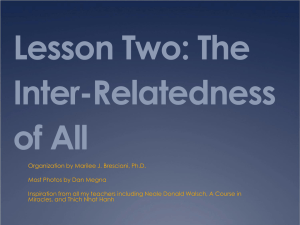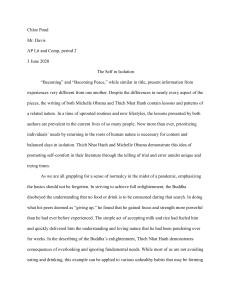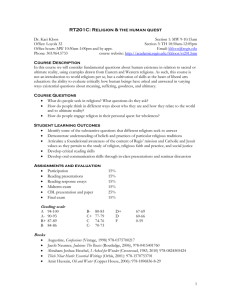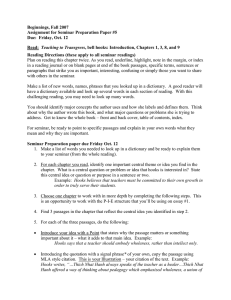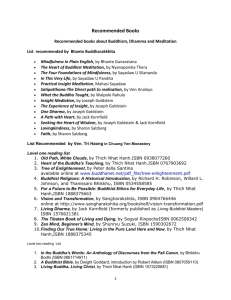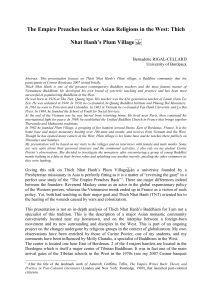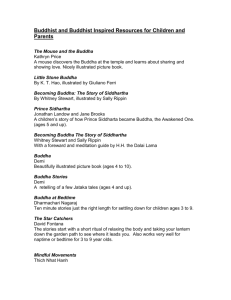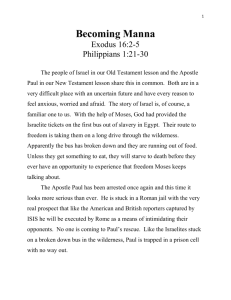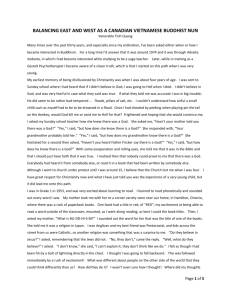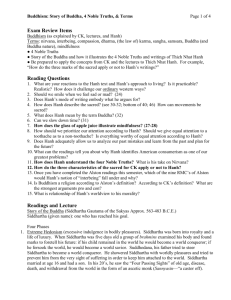NO DEATH, NO FEAR - Not exactly a book review
advertisement
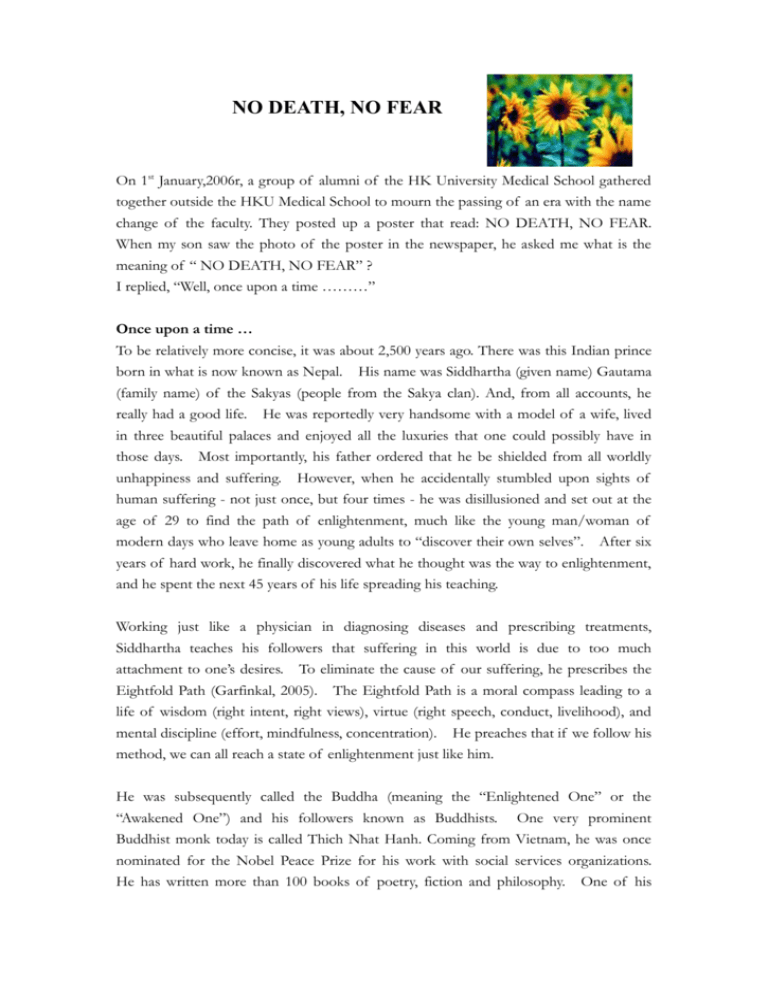
NO DEATH, NO FEAR On 1st January,2006r, a group of alumni of the HK University Medical School gathered together outside the HKU Medical School to mourn the passing of an era with the name change of the faculty. They posted up a poster that read: NO DEATH, NO FEAR. When my son saw the photo of the poster in the newspaper, he asked me what is the meaning of “ NO DEATH, NO FEAR” ? I replied, “Well, once upon a time ………” Once upon a time … To be relatively more concise, it was about 2,500 years ago. There was this Indian prince born in what is now known as Nepal. His name was Siddhartha (given name) Gautama (family name) of the Sakyas (people from the Sakya clan). And, from all accounts, he really had a good life. He was reportedly very handsome with a model of a wife, lived in three beautiful palaces and enjoyed all the luxuries that one could possibly have in those days. Most importantly, his father ordered that he be shielded from all worldly unhappiness and suffering. However, when he accidentally stumbled upon sights of human suffering - not just once, but four times - he was disillusioned and set out at the age of 29 to find the path of enlightenment, much like the young man/woman of modern days who leave home as young adults to “discover their own selves”. After six years of hard work, he finally discovered what he thought was the way to enlightenment, and he spent the next 45 years of his life spreading his teaching. Working just like a physician in diagnosing diseases and prescribing treatments, Siddhartha teaches his followers that suffering in this world is due to too much attachment to one’s desires. To eliminate the cause of our suffering, he prescribes the Eightfold Path (Garfinkal, 2005). The Eightfold Path is a moral compass leading to a life of wisdom (right intent, right views), virtue (right speech, conduct, livelihood), and mental discipline (effort, mindfulness, concentration). He preaches that if we follow his method, we can all reach a state of enlightenment just like him. He was subsequently called the Buddha (meaning the “Enlightened One” or the “Awakened One”) and his followers known as Buddhists. One very prominent Buddhist monk today is called Thich Nhat Hanh. Coming from Vietnam, he was once nominated for the Nobel Peace Prize for his work with social services organizations. He has written more than 100 books of poetry, fiction and philosophy. One of his books is called “ No Death, No Fear ” (Nhat Hanh, Thich, 2002), and it must have been this book, which inspired the slogan used in the 1st January mourning ceremony mentioned above. Why “No Death, No Fear”? In his book, Thich Nhat Hanh wrote: “Our greatest fear is that when we die we will become nothing. We believe that we are born from nothing and that when we die we become nothing. And so we are filled with the fear of annihilation. The Buddha has a very different understanding, that birth and death are just notions. They are not real.” This may sound like some semi-philosophical mumble-jumble to some readers of this column. To understand this we need to know about the Buddhist concept of “Impermanence”. The word “Impermanence” means that nothing in nature is identical with what it was the moment before (Smith, 1991). In his book “ No Death, No fear”, Thich Nhat Hanh uses some very good examples to illustrate this: 1. Look at a photo of yourself at the age of 16. The person that he has turned into is probably still called by your name, but it is a totally different person. A person is made of body, feelings, perceptions, mental formations, and consciousness, and all of these have changed since the picture was taken. So has that boy died and ceased to exist? In fact, your present self is a transient continuation of your past and it is constantly changing from moment to moment. 2. Look at the waves in the sea. It is fundamentally water and it would only appear because of other climactic factors. When it disappears, it just return to its own fundamental self as water waiting for the next opportunity to manifest itself again. There is no question of birth and death. 3. Look at the cloud in the sky. One day, it will become rain and if you look deeply into a drop of rainwater, you will see the cloud within it. In fact, walking by the garden and looking at a flower after raining and you will see the cloud in the flowers nurtured by the rainwater. So has the cloud died? Or did it in fact just manifest itself in another form? Our present self is but a manifestation of our genes. In fact these genes existed a long, long time ago. As Thich Nhat Hanh said: “We are in our grandfathers and our great-great-great grandfathers.” It is due to a certain particular combination of genes, which manifest themselves in a certain way that has led to the appearance of “you”, the person. If you have children, part of your genes will be passed on to them. They will also inherit some of your thoughts and their mental development will be influenced by you. Even if you do not have any children, your thoughts and actions must have touched a lot of people during your lifetime. Perhaps sometimes without your even knowing it, you may have done something or said something that have a profound impact on another human being. In a way, you continue to “live on” through others even after your physical form has disappeared from this world in the eyes of other people. Let us now look at the Faculty of Medicine of the HK University. Like all things on this earth, it came into existence because of a number of factors. Even if all the buildings disappeared overnight and the University should decide not to have any more medical school in the future, the Faculty of Medicine of the HK University will continue to exist through you and me who are graduates. It will also continue to exist in the patients that we have treated over the years, using the skills that we have acquired from the Faculty. In other words, there is NO DEATH and thus there is no need to fear DEATH itself. Some people think that if the name of the Faculty is changed, then the whole nature of the Faculty will be changed. They mourn because they think the old Faculty has died. They suffer and are in grief because they have an illusion that things are permanent and they get attached to that notion. The reality is that even without a name change, the Faculty will change physically and spiritually with the passage of time. This is inevitable as the nature of all things is “ impermanence”. So, come to think about it, why bother mourning the mere change of a name? References Garfinkal (2005). Buddha Rising, National Geographic Dec, 2005, pp 88 to 108. Smith, H (1991). The World’s Religions – Our Great Wisdom Traditions. Harper San Francisco, pp 117. Nhat Hanh, Thich (2002), No death, No fear, comforting wisdom for life. Published by the Berkley Publishing Group, New York.
